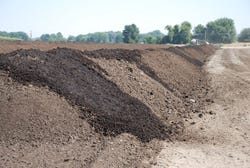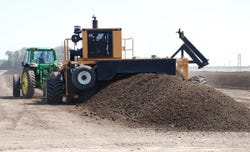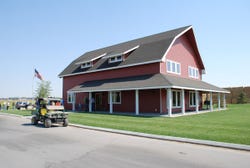M/M Feedlot wanted to expand its capacity but the extra manure from 4,000 cattle was prohibitive. Composting solved that problem and more.
March 30, 2012

When Darin Mann decided his future lay with the family feeding and farming operation in Parma, ID, he and his father Kent knew M/M Feedlot had to expand. One big challenge was how to dispose of the manure produced by an additional 4,000 head. Their resolution wasn’t more land, it was less manure – via composting.
M/M Feedlot lies about an hour west of Boise. The operation got its start back in 1947 when Darin’s grandfather settled in the area, cleared out the ubiquitous sagebrush, leveled the land and installed an irrigation infrastructure. Kent returned to the family operation in 1972 upon graduating from Brigham Young University (BYU). By that time, cattle feeding had been added to the operation.
In 1982, the operation added another component, a dairy heifer-development enterprise, which Kent eventually grew to 6,000 head. Today, the operation has a one-time capacity of 12,500 head and supplies replacement heifers to six large dairy operations in the Northwest.
 Those dairy calves come to the M/M Feedlot at six months of age; at 12-13 months of age, they’re bred artificially to their owners’ specifications. At 20 months of age and about seven months pregnant, the heifers are returned to the dairies, where they give birth and enter the milking string. Their calves will return to M/M Feedlot and the cycle continues.
Those dairy calves come to the M/M Feedlot at six months of age; at 12-13 months of age, they’re bred artificially to their owners’ specifications. At 20 months of age and about seven months pregnant, the heifers are returned to the dairies, where they give birth and enter the milking string. Their calves will return to M/M Feedlot and the cycle continues.
Darin graduated from BYU in 2001, after which he and wife Alison spent a year in China teaching English. He returned to the family farm operation nine years ago.
“Because manure contains a high percentage of water, it was cost-prohibitive to spread it on crop ground more than three miles from our feedlot,” Darin says. “We could only spread manure two times/year – after the fall harvest and before spring planting. That meant we had to stockpile manure for basically six months.”
The Manns began composting on a small scale about seven years ago, trying to learn “the science and the art,” as Darin puts it. “Once we kind of figured out what we were doing and the market, we set aside some land, got some equipment and jumped in big time about four years ago.” Today, they compost almost 100% of the manure produced in their feedlot.
The composting program results in corrals getting cleaned year-round and the concrete pads around the feed bunks and water troughs weekly. Cleaning is done with a tractor and a box scraper, moving the manure into concrete holding areas.
 Once the holding area is full, the manure is transported to one of two composting areas on either side of the feedlot. Constructed of packed natural clay, the two composting areas comprise about 30 acres. At the low end of each composting site is a large collection pond to capture runoff. The runoff is used as added moisture to the compost windrows during the first stage of the composting process.
Once the holding area is full, the manure is transported to one of two composting areas on either side of the feedlot. Constructed of packed natural clay, the two composting areas comprise about 30 acres. At the low end of each composting site is a large collection pond to capture runoff. The runoff is used as added moisture to the compost windrows during the first stage of the composting process.
Once the manure reaches the composting site, it’s placed into a 6-ft.-tall, 16-ft.-wide windrow about 800 ft. in length. Typically, the Manns have a total of 40 windrows under management. Once the windrows are constructed, it takes approximately 120 days for the composting process to be completed, depending on temperatures.
Part science, part art
“Producing compost is part science and part art,” Darin explains. “We’re working to achieve an optimal balance of nitrogen, carbon, water and oxygen. I’ve learned a lot through trial and error, and we finally have a solid process in place. We typically turn the windrows twice/week and, as we move through the process, it decreases to once/week. If water needs to be added, we drizzle it over the top of the windrow.”
Within the first 30-40 days, they attain the desired internal windrow temperature of 131° over a 15-consecutive-day period required to kill the E. coli, salmonella, weed seed and pathogens present in the manure. Temperature is monitored daily by inserting a 4-ft.-long probe into the windrow every 200 ft. during the first 15 days of the composting process. The readings help determine if the windrow needs to be turned to add more oxygen, or if water should be applied to help further activate the process.
M/M Feedlot uses a Wildcat 616 towable straddle compost turner in their operation. The unit’s 275-hp engine can process up to 3,000 tons/hour of compost, allowing them to completely turn all their windrows within one day.
Once the composting process is completed, the material is cured and screened according to customer specs. Ninety-five percent of the compost is sold to area farmers and is screened to 3/4-in. The rest is sold to landscapers, nurseries and garden centers and is processed using a 3/8-in. screen.
The Manns currently sell the compost for $13.50/ton, which Darin says is much cheaper than the true nutrient value.
“We never intended for the composting operation to be a revenue generator for our feedlot – we did it because it made environmental sense for our feedlot,” Darin says. “However, we’ve been surprised with the demand, which has allowed us to turn a small margin.”
The Manns live and share that environmental focus. M/M Feedlot was the Region V semifinalist for the 2012 Environmental Stewardship Award, and the operation regularly hosts field trips by school children, as well as government officials from the local, state and national levels. A lush one-acre park located in the very center of the feedyard is the showplace of the operation.
 So many folks think that a farm is a little red barn on a green hill with a white fence, and a few cows and chickens wandering around. But that’s not a farm anymore. That’s a hobby farm; that’s somebody’s weekend activity.
So many folks think that a farm is a little red barn on a green hill with a white fence, and a few cows and chickens wandering around. But that’s not a farm anymore. That’s a hobby farm; that’s somebody’s weekend activity.
“This is a farm,” Darin says, sweeping his arm. “We represent modern-day production agriculture. And we need to let people know that that’s what it is and not be afraid of it. Let’s tell our story first, rather than react.”
About the Author(s)
You May Also Like



